I have had the good fortune to be selected to test a prototype sample of the new Fenix PD32 flashlight. The Fenix PD32 arrived well packed in a large cardboard box, with sufficient paper cushioning. The box that houses the light is probably an unprinted version of the final product box, which has a window showing the light. The product documentation included was a set of three photocopied sheets with technical parameters, and general directions for use. No accessories were included with the light, so I will not have any comments about what may be included with the final product. My testing used the supplied Propel CR123 lithium batteries, and a Tenergy 18650 cell. Fenix recommends the use of two CR123 batteries, and a 18650 cell can be used with caution. The Fenix literature included with the light states that the use of RCR123 (16340 cells) is banned.
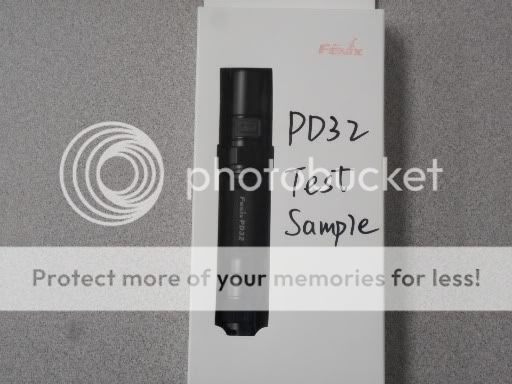
Out of the box, it is obvious that the PD32 is another quality offering from Fenix in the 1" performance light category. The black HAIII finish on the light is even, and all parts match well, with the exception of the reflector end of the head which has a slightly duller appearance than the rest of the light. The HAIII has a slight matte finish, but the smooth areas are still somewhat slick. The knurling is a raised diamond pattern that is grippy, but not so aggressive that it would damage clothing, or a flashlight sheath if used regularly. The threads on the light are square, and engage easily, without any wobble, or play.
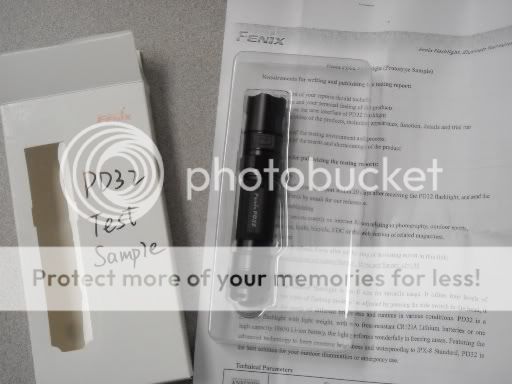
The tailcap is a tactical forward clicky, with a partially shrouded button. It is knurled around the middle, and has two lanyard slots machined into the raised areas. Unlike previous Fenix lights of this type, the tailcap in only used for turning the light on, or off. Mode switching on the PD32 is done at the head. The power switch is easy to press with a gloved hand, and the tactical switch has a solid feel. This light will not tail stand.
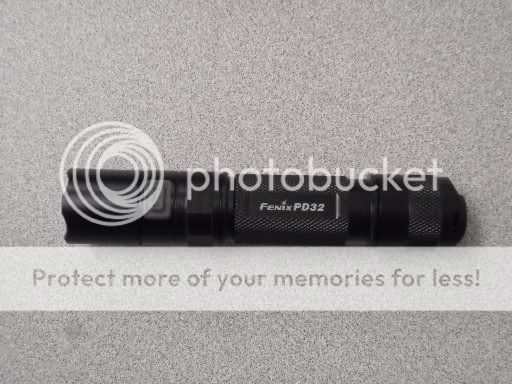
The body/battery tube has two machined flats for the laser etching, and two small flutes for appearance. One side of the light is etched with "Fenix PD32", and the other side says "Prototype Sample". The battery tube has been generously sized so that even large 18650 cells fit without binding. The CR123 cells rattle in the body when dropped into the tube, but there is no rattle at all when the head and tail are tightened. The head and tail end have a single o-ring for water resistance, and both head and tail feel secure when tightened.
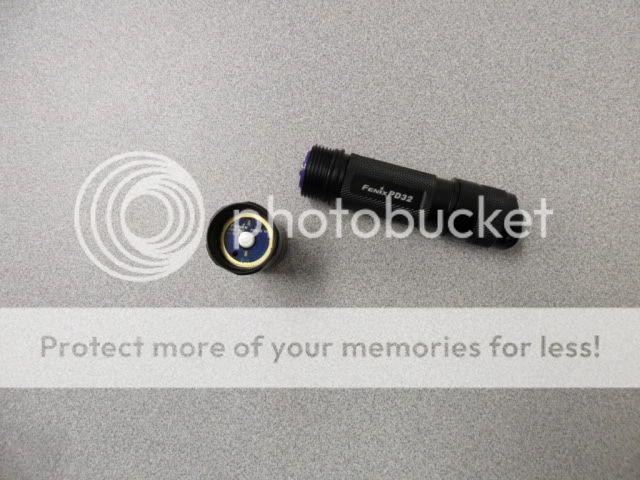
The head has a slightly crenulated bezel that is integral to the reflector end of the assembly. While the head bears some resemblance to earlier models, there is a not so obvious detail that sets it apart from previous Fenix lights of this type. A tactile switch mid head selects the modes. There are four general modes that can be cycled through with a single click of the mode switch, and a press/hold will access strobe and SOS modes. The light has a memory function for the last mode used, and it worked well each time that I have used the light. The reflector is smooth, which provides excellent throw, but also causes some rings. Even with the smooth reflector, there is a lot of spill with this light. I like a smooth reflectored light, and I can certainly handle the associated rings when the beam is this full. The button is slightly raised, and has a good texture, but is difficult to find with gloves. However, once found it is easy to press regardless of what is on your hands. The anti-roll flats are not very effective in preventing the light from rolling when on an inclined surface. I would consider them more for aesthetics than for function.
The light uses a CREE XP-G R5 LED with an excellent white tint that has no hint of blue, or yellow.
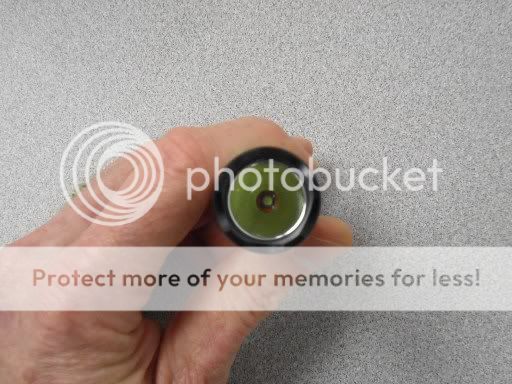
The 3 lumen low is surprisingly bright in dark areas, and the 315 lumen turbo mode is honest out-the-front lumens. With complete objectivity, I can say that the amount of light that the PD32 produces is impressive. Everybody that has seen the light has been shocked by the output in turbo mode. On my sample, the center of the beam is not as bright as the surrounding area. There is also a dark spot in the beam (approximately 2:00 in the pictures) that appears to be a flaw in the LED, or some debris on the LED surface. The pictures do not show the beam with the same clarity as in person, but give a decent representation of the general appearance.
3 lumens @ 2M. Advertised runtime Low = 200h.
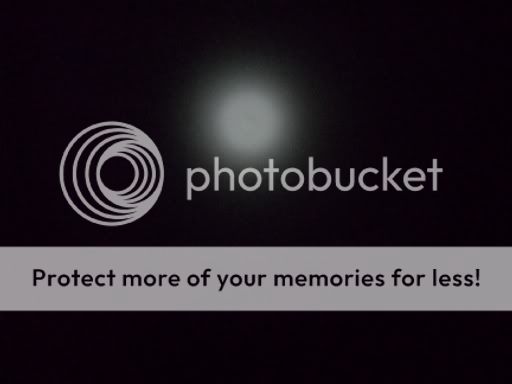
70 lumens @ 2M. Advertised runtime Mid = 16h.
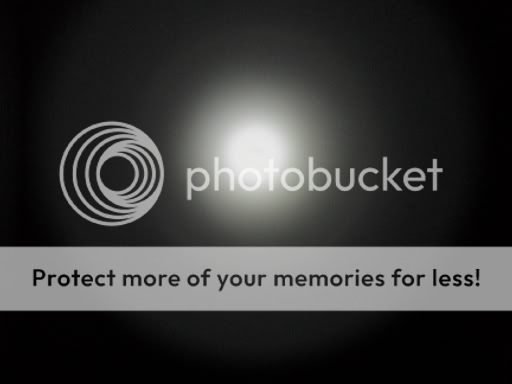
130 lumens @ 2M. Advertised runtime High = 8h.
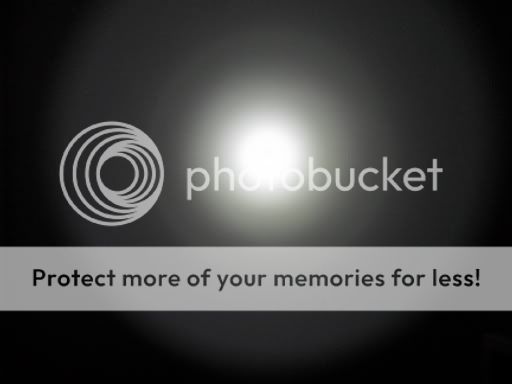
315 lumens @ 2M. Advertised runtime Turbo = 2h. (Stepdown at 30 minutes.)
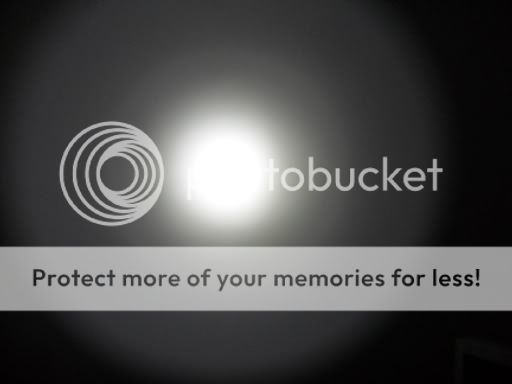
315 lumens @ 5M.
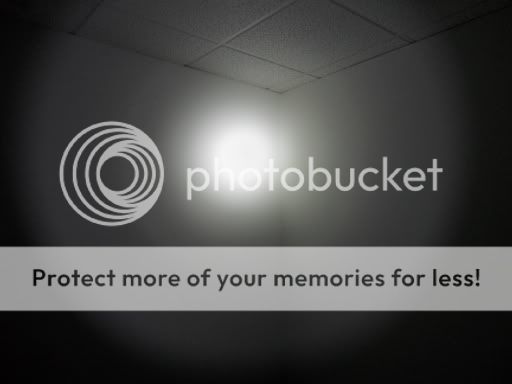
The light rigged with a length if cord and a ribbon marking 1M. I was on my way to test the light in the dark on the trail near my house, and to test the water resistance at the pond with the light submerged for 5 minutes on turbo mode.
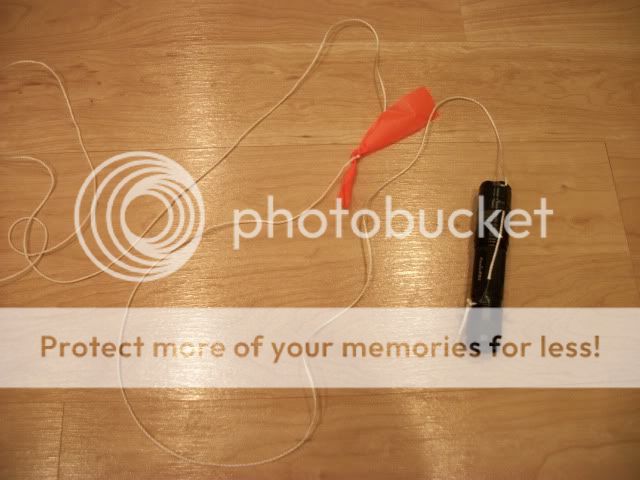
The PD32 with a Quark 123^2 for size reference.
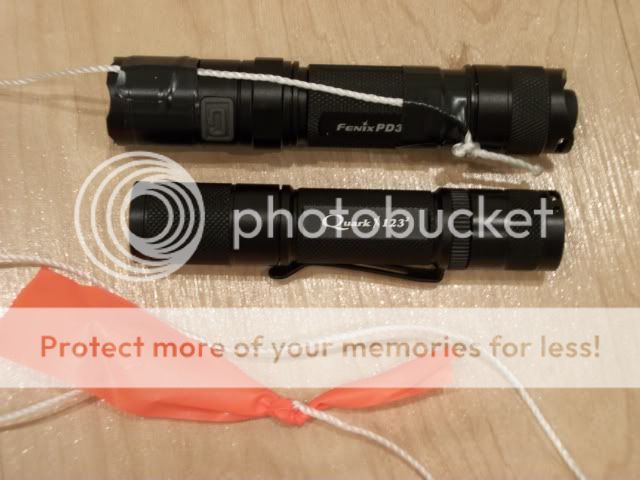
A shot on the paved trail on medium. The low shot looked so much like the control shot (black), that I didn't use either picture. (The low level is bright enough for low speed navigation and close tasks in the dark.) Once I got to the pond trail, I realized that I should have brought my tripod. The longer exposures showed signs of movement, though I was holding the camera as still as possible. If the trail wasn't so far from the house, I would have gone home to get the tripod. I may redo the pictures later.
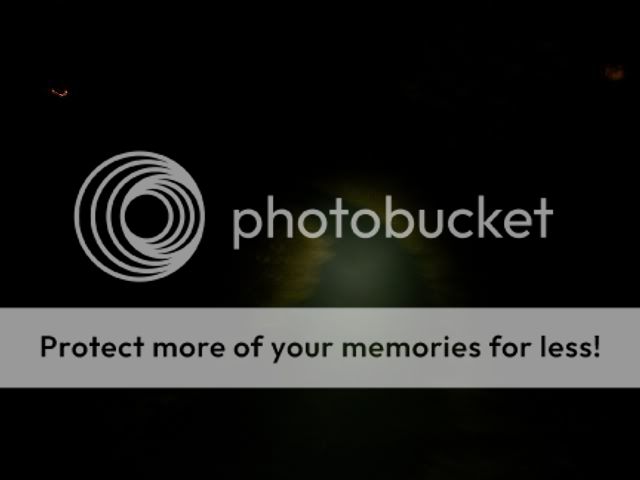
High. The dark spot in the center of beam is visible.
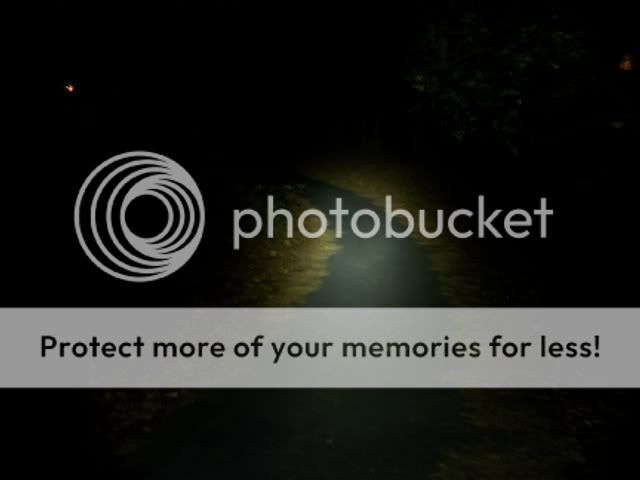
Turbo. The dark spot in the center of the beam is really visible in this shot.
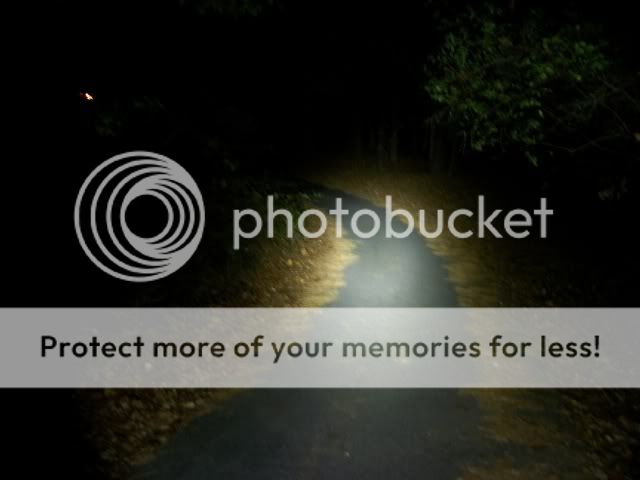
A shot looking into a golf cart tunnel on the trail. This is on medium.
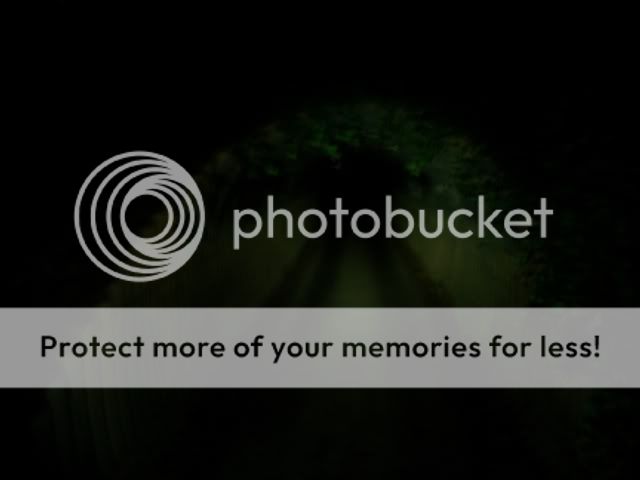
High
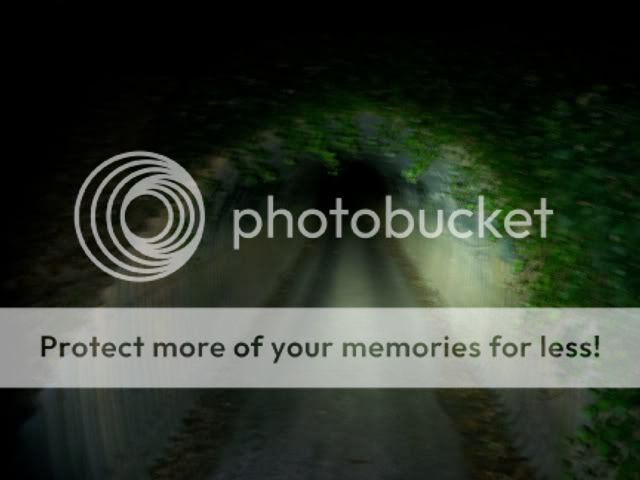
Turbo - In person, this was crazy bright. I was glad that someone didn't come from the other direction! While it is not apparent unless you look for it, the bright area around the darker beam center is visible in the shot.

The PD32 submerged 1M in the pond. You can see the orange ribbon marking the 1M depth. I left the light submerged for 5 minutes on turbo mode. This drew some curiosity from some teenagers who came to the pond to do some late night fishing. Two guys were giving fishing lessons to their girlfriends.
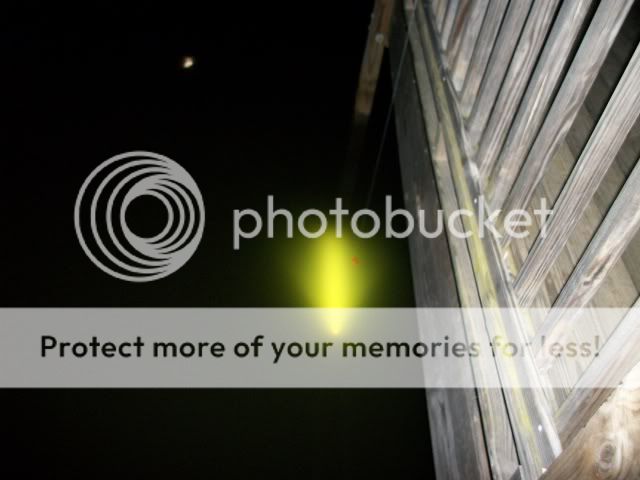
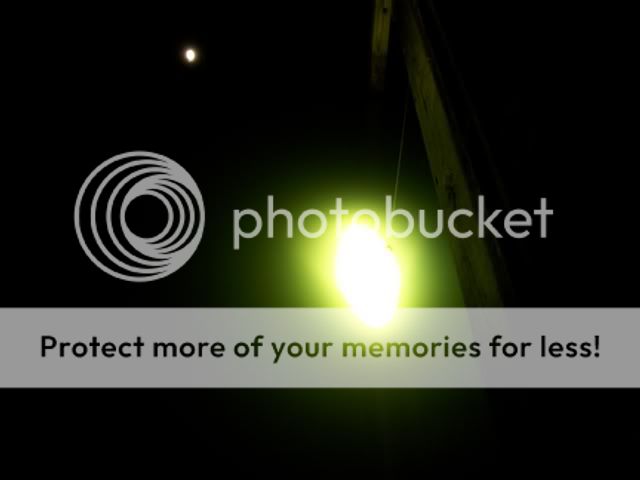
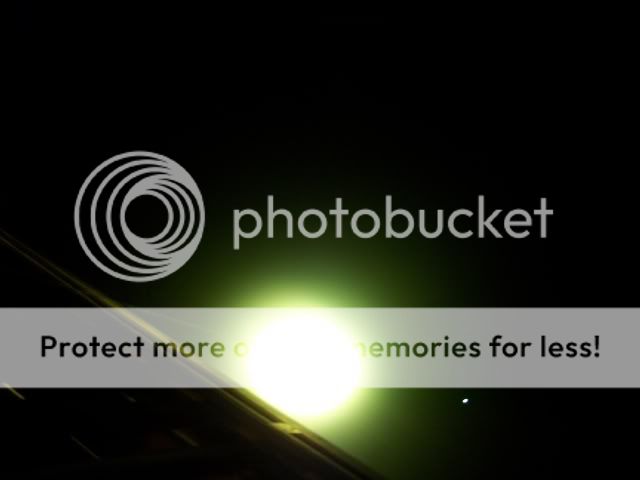
Here is a fish that one of the girls caught using a ham chunk for bait. Yes, it really is only 2" long.
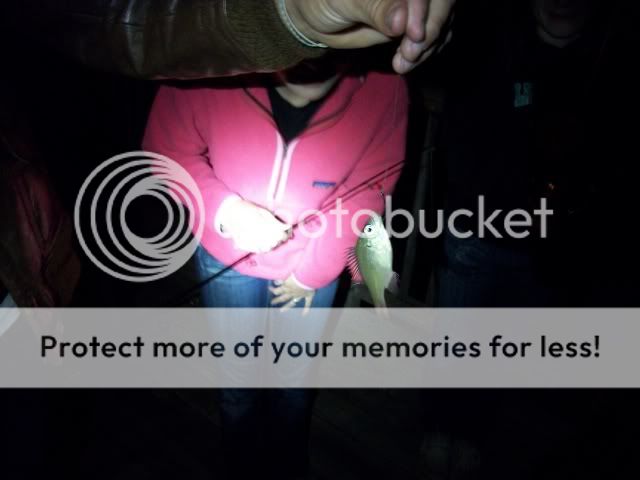
The light did not have any water seep into it's insides, and there hasn't been any condensation showing on the lens.
I measured the Lux readings of the light on 2x CR123s, and a Tenergy 18650 (2200mAh). I used two light meters for redundant measurements, and was able to get the same reading on both light meters (within 10 lux maximum). I used a Meterman LM631, and a light meter that I purchased from Deal Extreme.
2X CR123
Low: 50
Med: 630
High: 1120
Turbo: 2850
18650
Low: 40
Med: 580
High: 1120
Turbo: 2720
The following list of pros and cons can point out the other features of the light based on my personal perceptions.
Pros:
Well spaced light levels
Bright
Decent spill
Crenulated bezel (more lights should have this feature)
Forward clicky tail switch
Tail switch is easy to activate with gloves
Good knurling and grip
Memory for last used mode
Easy, intuitive UI
Cons:
Center of beam darker than surrounding area
Dark spot in beam (from spot on LED, or LED die?)
Doesn't tail stand
Level switch hard to locate in the dark
Anti-roll body only marginally effective
While the review and comments are based on my personal preferences, I was trying to be as objective as possible.
The PD32 is a well designed light with a nice range of brightness levels. The high level is more than respectable, while turbo mode is impressive. What I liked the most about the light was that it had a good amount of spill despite being a smooth reflectored light with good throw. It was brighter than I had expected, and the low level is about right for close tasks. What I liked the least about the light is the dark spot in the beam, and that I could not find the level switch easily when I was in the dark. Regardless, this is a light that I will be using often. In anticipation of the obvious question "Would you buy one?", the answer is "Yes, if the beam is improved".

Out of the box, it is obvious that the PD32 is another quality offering from Fenix in the 1" performance light category. The black HAIII finish on the light is even, and all parts match well, with the exception of the reflector end of the head which has a slightly duller appearance than the rest of the light. The HAIII has a slight matte finish, but the smooth areas are still somewhat slick. The knurling is a raised diamond pattern that is grippy, but not so aggressive that it would damage clothing, or a flashlight sheath if used regularly. The threads on the light are square, and engage easily, without any wobble, or play.

The tailcap is a tactical forward clicky, with a partially shrouded button. It is knurled around the middle, and has two lanyard slots machined into the raised areas. Unlike previous Fenix lights of this type, the tailcap in only used for turning the light on, or off. Mode switching on the PD32 is done at the head. The power switch is easy to press with a gloved hand, and the tactical switch has a solid feel. This light will not tail stand.

The body/battery tube has two machined flats for the laser etching, and two small flutes for appearance. One side of the light is etched with "Fenix PD32", and the other side says "Prototype Sample". The battery tube has been generously sized so that even large 18650 cells fit without binding. The CR123 cells rattle in the body when dropped into the tube, but there is no rattle at all when the head and tail are tightened. The head and tail end have a single o-ring for water resistance, and both head and tail feel secure when tightened.

The head has a slightly crenulated bezel that is integral to the reflector end of the assembly. While the head bears some resemblance to earlier models, there is a not so obvious detail that sets it apart from previous Fenix lights of this type. A tactile switch mid head selects the modes. There are four general modes that can be cycled through with a single click of the mode switch, and a press/hold will access strobe and SOS modes. The light has a memory function for the last mode used, and it worked well each time that I have used the light. The reflector is smooth, which provides excellent throw, but also causes some rings. Even with the smooth reflector, there is a lot of spill with this light. I like a smooth reflectored light, and I can certainly handle the associated rings when the beam is this full. The button is slightly raised, and has a good texture, but is difficult to find with gloves. However, once found it is easy to press regardless of what is on your hands. The anti-roll flats are not very effective in preventing the light from rolling when on an inclined surface. I would consider them more for aesthetics than for function.
The light uses a CREE XP-G R5 LED with an excellent white tint that has no hint of blue, or yellow.

The 3 lumen low is surprisingly bright in dark areas, and the 315 lumen turbo mode is honest out-the-front lumens. With complete objectivity, I can say that the amount of light that the PD32 produces is impressive. Everybody that has seen the light has been shocked by the output in turbo mode. On my sample, the center of the beam is not as bright as the surrounding area. There is also a dark spot in the beam (approximately 2:00 in the pictures) that appears to be a flaw in the LED, or some debris on the LED surface. The pictures do not show the beam with the same clarity as in person, but give a decent representation of the general appearance.
3 lumens @ 2M. Advertised runtime Low = 200h.

70 lumens @ 2M. Advertised runtime Mid = 16h.

130 lumens @ 2M. Advertised runtime High = 8h.

315 lumens @ 2M. Advertised runtime Turbo = 2h. (Stepdown at 30 minutes.)

315 lumens @ 5M.

The light rigged with a length if cord and a ribbon marking 1M. I was on my way to test the light in the dark on the trail near my house, and to test the water resistance at the pond with the light submerged for 5 minutes on turbo mode.

The PD32 with a Quark 123^2 for size reference.

A shot on the paved trail on medium. The low shot looked so much like the control shot (black), that I didn't use either picture. (The low level is bright enough for low speed navigation and close tasks in the dark.) Once I got to the pond trail, I realized that I should have brought my tripod. The longer exposures showed signs of movement, though I was holding the camera as still as possible. If the trail wasn't so far from the house, I would have gone home to get the tripod. I may redo the pictures later.

High. The dark spot in the center of beam is visible.

Turbo. The dark spot in the center of the beam is really visible in this shot.

A shot looking into a golf cart tunnel on the trail. This is on medium.

High

Turbo - In person, this was crazy bright. I was glad that someone didn't come from the other direction! While it is not apparent unless you look for it, the bright area around the darker beam center is visible in the shot.

The PD32 submerged 1M in the pond. You can see the orange ribbon marking the 1M depth. I left the light submerged for 5 minutes on turbo mode. This drew some curiosity from some teenagers who came to the pond to do some late night fishing. Two guys were giving fishing lessons to their girlfriends.



Here is a fish that one of the girls caught using a ham chunk for bait. Yes, it really is only 2" long.

The light did not have any water seep into it's insides, and there hasn't been any condensation showing on the lens.
I measured the Lux readings of the light on 2x CR123s, and a Tenergy 18650 (2200mAh). I used two light meters for redundant measurements, and was able to get the same reading on both light meters (within 10 lux maximum). I used a Meterman LM631, and a light meter that I purchased from Deal Extreme.
2X CR123
Low: 50
Med: 630
High: 1120
Turbo: 2850
18650
Low: 40
Med: 580
High: 1120
Turbo: 2720
The following list of pros and cons can point out the other features of the light based on my personal perceptions.
Pros:
Well spaced light levels
Bright
Decent spill
Crenulated bezel (more lights should have this feature)
Forward clicky tail switch
Tail switch is easy to activate with gloves
Good knurling and grip
Memory for last used mode
Easy, intuitive UI
Cons:
Center of beam darker than surrounding area
Dark spot in beam (from spot on LED, or LED die?)
Doesn't tail stand
Level switch hard to locate in the dark
Anti-roll body only marginally effective
While the review and comments are based on my personal preferences, I was trying to be as objective as possible.
The PD32 is a well designed light with a nice range of brightness levels. The high level is more than respectable, while turbo mode is impressive. What I liked the most about the light was that it had a good amount of spill despite being a smooth reflectored light with good throw. It was brighter than I had expected, and the low level is about right for close tasks. What I liked the least about the light is the dark spot in the beam, and that I could not find the level switch easily when I was in the dark. Regardless, this is a light that I will be using often. In anticipation of the obvious question "Would you buy one?", the answer is "Yes, if the beam is improved".
Last edited:


